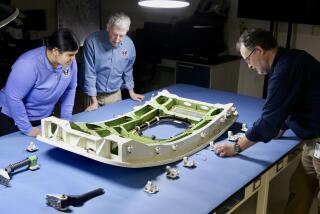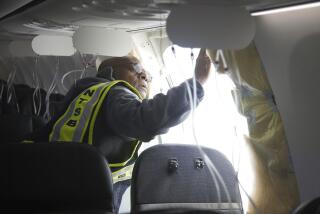Jet Tail-Engine Disk Found in Field Had Crack
- Share via
WASHINGTON — A mammoth tail-engine disk whose rupture is thought to have caused the crash of United Airlines Flight 232 last July was cracked even before the plane took off, federal investigators said Thursday.
The flaw, discovered in the first inspection of the crucial DC-10 part since it was discovered half-buried in a cornfield this week, provides the strongest clue so far to the reason for the sudden engine explosion 37,000 feet above Iowa.
In announcing the finding, the National Transportation Safety Board cautioned that it had not yet determined whether the crack caused the disk failure, as its investigators have theorized. It said that it also remains unclear whether the flaw could have been detected before the accident. But Jim Kolstad, acting safety board chairman, indicated that investigators are hopeful that the discovery of the crack in the long-lost engine part will enable the agency to draw firm conclusions about the cause of the bizarre accident, which claimed 112 lives.
The July 19 crash at Sioux City occurred after the explosion hurled shards of metal that severed the jumbo jet’s hydraulic lines. Unable to manipulate the rudder and flaps, pilots guided the crippled plane to a runway before it cartwheeled on landing and burst into flames.
Investigators long had suspected that the titanium disk, which held the engine’s 38 fan blades, bore responsibility for the explosion, particularly after finding a metal impurity in a similar disk from another plane. But a three-month search failed to turn up the 300-pound part, prompting fears that the mystery might never be solved.
An Alta, Iowa, farmer had found the battered disk and blades while operating farm machinery in a cornfield Tuesday afternoon. General Electric, the engine builder, said Thursday that it would pay Janice Sorenson a reward of $130,000.
The disk portion contained about two-thirds of the entire fan blade, and was missing a pie-shaped slice, along with 13 fan blades and their roots.
The investigators, who examined the part at GE’s engine headquarters in Evendale, Ohio, said that preliminary examinations indicated the crack on the interior surface of the disk was “pre-existing.”
Their descriptions suggested that the flaw was jagged in shape, extending both horizontally along the surface of the disk and vertically toward its rim. But in a statement, they reported that the “size, nature, age and reasons for the crack have not yet been determined.”
While the investigators also emphasized that there had been “no determination” whether the crack was “detectable” before Flight 232 took off, the knowledge that it was “pre-existing” suggests that the tragedy might have been avoided.
In reaction to the accident, the Federal Aviation Administration already has ordered inspections of 220 jet engines like the one involved in the United Airlines crash. The agency directive, issued last month, requires that checks be completed by February of all disks produced by the same method used on the disk that failed in the United plane.
More to Read
Sign up for Essential California
The most important California stories and recommendations in your inbox every morning.
You may occasionally receive promotional content from the Los Angeles Times.













